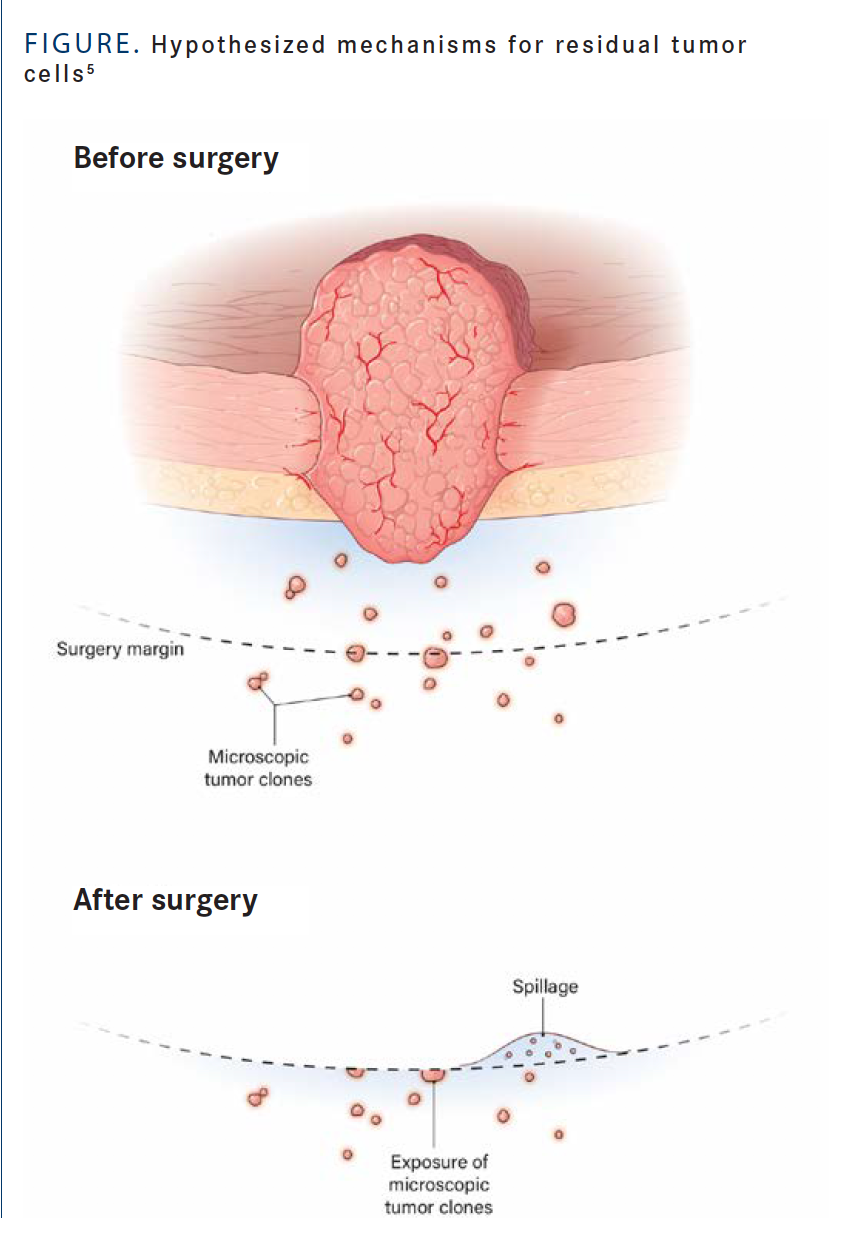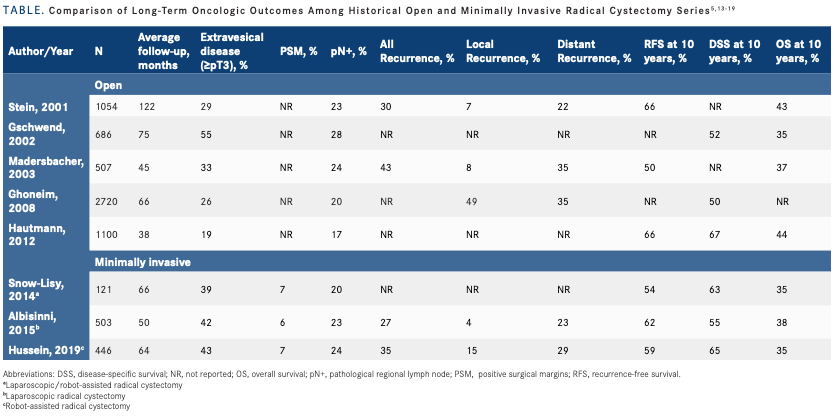Publication
Article
Oncology Live®
Robot-Assisted Cystectomy Is Feasible for Many Patients With Bladder Cancer
To determine the 10-year oncologic outcomes and recurrence patterns after robot-assisted radical cystectomy, a group within the Department of Urology at Roswell Park Comprehensive Cancer Center performed a retrospective review.
Ahmed A. Hussein Aly, MD, PhD

Qiang John Li, MD, PhD

Radical cystectomy (RC) with pelvic lymphadenectomy and urinary diversion represents the standard of care for the management of patients with organ-confined muscle-invasive bladder cancer and refractory nonmuscleinvasive disease. A significant increase in the uptake of robot-assisted RC (RARC) has been noted over the past decade, growing from less than 1% in 2004 to approximately 23% in 2014.1 RARC has been shown to be superior to its counterpart in terms of the reduction of blood loss, transfusion rates, and hospital stays, in addition to improved visualization and ergonomics for the surgeon. The RAZOR trial (Randomized Open vs Robotic Cystectomy; NCT01157676) showed similar progressionfree and overall survival as well as complications in patients receiving either approach, up to 3 years after cystectomy.2,3 However, few reports suggested higher rates of local recurrence and peritoneal carcinomatosis following the robotic approach.4 Moreover, data regarding longer-term oncologic outcomes are still lacking.
To determine the 10-year oncologic outcomes and recurrence patterns after RARC, our group within the Department of Urology at Roswell Park Comprehensive Cancer Center performed a retrospective review of the prospectively maintained International Robotic Cystectomy Consortium database of more than 3000 patients across 28 institutions from 14 countries. We identified 446 patients who underwent RARC 10 or more years ago. Of these, 43% had extravesical disease (≥pT3) and 24% had lymph node–positive disease. Positive soft tissue surgical margins occurred in 30 patients (7%). At a median follow-up of 5 years, we observed that 35% of patients had their cancer relapse, 15% developed local recurrence, and 29% developed distant metastasis. Peritoneal carcinomatosis was observed in 6 patients (1%), and no port-site recurrences were reported. The 10-year recurrence-free, disease-specific, and overall survival rates were 59%, 65% and 35%, respectively.5 These results demonstrate comparable long-term oncologic outcomes as well as recurrence patterns compared with large open cystectomy series (Table).5, 13-19
The pathogenesis of recurrence following RC is yet to be determined, but it is likely multifactorial. Tumor aggressiveness, occult metastatic disease at the time of surgery, inhibited host immune response, laparoscopy-related factors, or breaching of oncologic surgical principles (ie, vigorous surgical manipulation, specimen morcellation, entry into the bladder, and retrieval method) have been investigated as possible influencers.13
Figure. Hypothesized Mechanisms for Residual Tumor Cells5

The contribution of carbon dioxide pneumoperitoneum deployed in minimally invasive surgery also remains unknown. Prior preclinical studies have suggested that carbon dioxide pneumoperitoneum may inhibit peritoneal immune response against malignant urothelial cells and may contribute to recurrences within the pelvis and at port sites.14 However, our data showed that most patients who experienced early or unusual recurrences had advanced disease (89%), and oncologic principles were breached in 8%. For any RC performed—either open or RARC—tumor stage, nodal involvement, lymphovascular invasion, and positive soft tissue surgical margins are the most powerful predictors of tumor recurrence.
Table. Comparison of Long-Term Oncologic Outcomes Among Historical Open and Minimally Invasive Radical Cysectomy Series5,13-19

Interestingly, pneumoperitoneum pressure was not associated with early oncologic failure. Prior reports suggested that high and/or pulsatile pneumoperitoneum, especially inlengthy procedures, may enhance tumor cell migration from the venous plexus of the bladder—the pedicles are squeezed throughout the procedure—and contribute to early tumor recurrence.15 In summary, based on availble evidence, disease-related rather than technicalor laparoscopy-related factors play a major role in early or unusual recurrences after RARC.16
Innovation for the Future of RARC
Our team has developed a novel approach to objectively evaluate the presence of cancer cells and their gene-related products in the pelvis and pneumoperitoneum during RARC. We demonstrated the feasibility of using ultradeep sequencing to achieve accurate quantification of residual cancer cells in the pelvic washings of patients undergoing RARC. The identified patterns of residual cancer cells suggest that they are unlikely to be caused by random tumor spillage during surgery and more likely indicate the preexistence of infiltrating micrometastatic tumor clones—clearly reflecting the tumor’s level of aggressiveness. This analysis revealed a potential association between residual cancer cells and aggressive histology and cancer recurrence17,18 (Figure 5).
Our growing experience allowed for stepwise robot-assisted (RA) surgical management of bladder cancer at our center; early in our learning curve, the focus was to achieve oncological efficacy. Once this was achieved, more attention was paid to optimizing operative time, followed by incorporation of intracorporeal diversion and RA surgical management of complications.
We noted that the enhanced experience and adequate visualization and access to challenging anatomical regions associated with RA surgery afforded us the opportunity to operate on more technically complex cases. Surgical interventions, especially with an invasive approach, expose vulnerable patients to considerable risks. These are patients who typically present with multiple comorbidities and have already undergone major surgery. Moreover, interventions are usually challenging, owing to technical complexity as a result of abdominal adhesions and altered anatomy following cystectomy.
The incidence of employing robotics for complex genitourinary reconstructive procedures is increasing. Our initial experience with RA management of RARC complications provides solid evidence that it is a safe and feasible option. The decision on how to proceed should always be determined based on surgeon experience and shared decision making with each patient.19
References:
- Burger M, Catto JW, Dalbagni G, et al. Epidemiology and risk factors of urothelial bladder cancer. Eur Urol. 2013;63(2):234-241. doi:10.1016/j.eururo.2012.07.033
- Parekh DJ, Reis IM, Castle EP, et al. Robot-assisted radical cystectomy versus open radical cystectomy in patients with bladder cancer (RAZOR): an open-label, randomised, phase 3, non-inferiority trial. Lancet. 2018;391(10139):2525-2536. doi:10.1016/S0140-6736(18)30996-6
- Venkatramani V, Reis IM, Castle EP, et al. Predictors of recurrence, and progression-free and overall survival following open versus robotic radical cystectomy: analysis from the RAZOR trial with a 3-year followup. J Urol. 2020;203(3):522-529. doi:10.1097/JU.0000000000000565
- Nguyen DP, Al Hussein Al Awamlh B, Wu X , et al. Recurrence patterns after open and robot-assisted radical cystectomy for bladder cancer. Eur Urol. 2015;68(3):399-405. doi:10.1016/j.eururo.2015.02.003
- Hussein AA, Elsayed AS, Aldhaam NA, et al. Ten-year oncologic outcomes following robot-assisted radical cystectomy: results from the International Robotic Cystectomy Consortium. J Urol. 2019;202(5):927-935. doi:10.1097/JU.0000000000000386
- SteinJP, Lieskovsky G, Cote R, et al. Radical cystectomy in the treatment of invasive bladder cancer: long-term results in 1,054 patients. J Clin Oncol. 2001;19(3):666-675. doi:10.1200/JCO.2001.19.3.666
- Gschwend JE, Dahm P, Fair WR. Disease specific survival as endpoint of outcome for bladder cancer patients following radical cystectomy. Eur Urol. 2002;41(4):440-448. doi:10.1016/s0302-2838(02)00060-x
- Madersbacher S, Hochreiter W, Burkhard F, et al. Radical cystectomy for bladder cancer today—a homogeneous series without neoadjuvant therapy. J Clin Oncol. 2003;21(4):690-696. doi:10.1200/JCO.2003.05.101
- Ghoneim MA, Abdel-Latif M, el-Mekresh M, et al., Radical cystectomy for carcinoma of the bladder: 2,720 consecutive cases 5 years later. J Urol. 2008;180(1):121-7. doi:10.1016/j.juro.2008.03.024
- Hautmann RE, de Petriconi RC, Pfeiffer C, Volkmer BG. Radical cystectomy for urothelial carcinoma of the bladder without neoadjuvant or adjuvant therapy: long-term results in 1100 patients. Eur Urol. 2012;61(5):1039-47. doi:10.1016/j.eururo.2012.02.02
- Snow-Lisy DC, Campbell SC, Gill IS, et al. Robotic and laparoscopic radical cystectomy for bladder cancer: long-term oncologic outcomes. Eur Urol. 2014;65(1):193-200. doi:10.1016/j.eururo.2013.08.021
- Albisinni S, Rassweiler J, Abbou CC, et al. Long-term analysis of oncological outcomes after laparoscopic radical cystectomy in Europe: results from a multicentre study by the European Association of Urology (EAU) section of Uro-technology. BJU Int. 2015;115(6):937-45. doi:10.1111/bju.12947
- Tsivian A, Sidi AA. Port site metastases in urological laparoscopic surgery. J Urol. 2003;169(4)1213-1218. doi:10.1097/01.ju.0000035910.75480.4b
- Ost MC, Patel KP, Rastinehad AR, et al. Pneumoperitoneum with carbon dioxide inhibits macrophage tumor necrosis factor-alpha secretion: source of transitional-cell carcinoma port- site metastasis, with prophylactic irrigation strategies to decrease laparoscopic oncologic risks. J Endourol. 2008;22(1):105-112. doi:10.1089/end.2007.9858
- Hewett PJ, Thomas WM, King G, Eaton M. Intraperitoneal cell movement during abdominal carbon dioxide insufflation and laparoscopy. An in vivo model. Dis Colon Rectum. 1996; 39(suppl 10):S62-66. doi:10.1007/bf02053808
- Hussein AA, Saar M, May PR, et al. Early oncologic failure after robot-assisted radical cystectomy: results from the International Robotic Cystectomy Consortium. J Urol. 2017; 197(6):1427-1436. doi:10.1016/j.juro.2016.12.048
- Hussein AA, Ma Y, Azabdaftari G, et al. MP 38-05 tumor dessimination during robot-assisted radical cystectomy: does the emperor have no clothes? J Urol. 2016;195(suppl 4):e534-535. doi:10.1016/j.juro.2016.02.109
- Wei L, Hussein AA, Ma Y, et al. Accurate quantification of residual cancer cells in pelvic washing reveals association with cancer recurrence following robot-assisted radical cystectomy. J Urol. 2019;201(6):1105-1114. doi:10.1097/JU.0000000000000142
- Hussein AA, Hashmi Z, Dibaj S, et al. Reoperations following robot-assisted radical cystectomy: a decade of experience. J Urol. 2016; 195(5):1368-1376. doi:10.1016/j.juro.2015.10.171






























%20(2)%201-Recovered-Recovered-Recovered-Recovered-Recovered-Recovered-Recovered-Recovered-Recovered-Recovered-Recovered-Recovered-Recovered-Recovered-Recovered-Recovered-Recovered.jpg?fit=crop&auto=format)
%20(2)%201-Recovered-Recovered-Recovered-Recovered-Recovered-Recovered-Recovered-Recovered-Recovered-Recovered-Recovered-Recovered-Recovered-Recovered-Recovered-Recovered-Recovered.jpg?fit=crop&auto=format)
